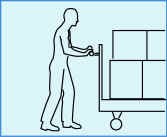Hospitals eTool
Housekeeping » Work-related Musculoskeletal Disorders
Hazards
Housekeepers are exposed to ergonomics hazards, which may lead to strain and sprains, while performing job tasks such as:

- Pushing and pulling heavy carts full of dirty or clean items.
- Using improperly designed hand tools.
- Reaching into deep sinks or containers when cleaning/washing small objects.
- Using floor and backpack vacuum cleaners.
- Moving beds during cleaning duties.
- Lifting and holding mattresses to tuck-in bed linens.
- Prolonged work in awkward postures (e.g., long reaches and kneeling) to clean bathrooms.
Recognized Controls and Work Practices
Assess worksites for ergonomic hazards and address ways to decrease them:
- Redesign or reposition tasks to allow elbows to remain close to the body. Maintain a neutral (handshake) wrist position.
- Select and use properly designed tools. For example, use tools with extended handles, or step stools, or ladders to avoid or limit overhead reaching and kneeling. Choose tools with padded and non-slip handles.

Well maintained rolling cart with large, low-resistance wheels. - Avoid awkward postures such as bending, twisting, shoulder abduction, and wrist deviation (e.g., reposition work in front of worker rather than reaching above the shoulders or behind the torso).
- Use rolling carts with large, low-resistance wheels that can easily roll over mixed flooring as well as gaps between elevators and hallways to transport supplies rather than carrying them.
- Clean objects at waist level if possible, rather than bending over them (e.g., push wheelchairs up a ramped platform to perform cleaning work, or raise beds to waist level before cleaning).
- Lighten a load that needs to be lifted or get help when lifting.
- Restructure jobs to reduce repeated motions, forceful hand exertions, and prolonged bending.
- Train workers to use proper lifting techniques for trash bag lifting and carrying.
- Limit reaching or lifting hazards when lifting trash or other kinds of bags by:
- Using handling bag for garbage, laundry, and housekeeping, when possible, that have side openings to allow for easy disposal without reaching into and pulling bags up and out. The handling bags will slide off the cart without lifting.
- Limiting the size and weight of these bags and providing handles to further decrease lifting hazards.
- Keep carts or hampers well maintained to minimize the amount of force exerted while using these items.
- Keep handles of devices to be pushed at waist to chest height.

Handling bag. - Use handles – and not the sides of carts -- to move carts, to prevent the accidental smashing of hands and fingers. Push rather than pull whenever possible.

Plastic basin in the bottom of the sink. - If using a deep sink, limit excessive reaching and back flexion by:
- Placing an object such as a plastic basin in the bottom of the sink to raise the washing-surface up.
- Removing objects to be washed into a smaller container on the counter for scrubbing or soaking and then replacing them back in the sink for final rinse.

The following are recommended when performing cleaning tasks:
- Alternate leading hand.
- Avoid tight and static grip and use padded non-slip handles.
- Use knee pads when kneeling.
- When sweeping or dusting, use flat-head dusters and push with the leading edge; sweep all areas into one pile and pick up with a vacuum.
- Use chemical cleaners and soak items to be cleaned to minimize the force needed for scrubbing.
- Frequently change mopping styles when mopping (e.g., push/pull and rocking side to side) to alternate stress on muscles.
- Be sure that buckets, vacuums, and other cleaning tools have wheels, or are on wheeled carts, with functional brakes.
- Alternate tasks or rotate employees through stressful tasks.
- Use buffers and vacuums that have lightweight construction, vibration reduction and adjustable handles.
- Use spray bottles and equipment that have trigger bars rather than single finger triggers.
- Use fitted sheets to eliminate lifting mattresses when changing the bed sheets.
Additional Information
- Ergonomics. OSHA Safety and Health Topics Page.
- Musculoskeletal Disorders and Workplace Factors - A Critical Review of Epidemiologic Evidence for Work-related Musculoskeletal Disorders of the Neck, Upper Extremity, and Low Back. U.S. Department of Health and Human Services (DHHS), National Institute for Occupational Safety and Health (NIOSH) Publication No. 97-141, (July 1997).
- Inspection Guidance for Inpatient Healthcare Settings. (June 25, 2015). OSHA memorandum establishing guidance for inspections conducted in inpatient healthcare settings.
- Also see Hospital-wide Hazards - Work-related Musculoskeletal Disorders.

